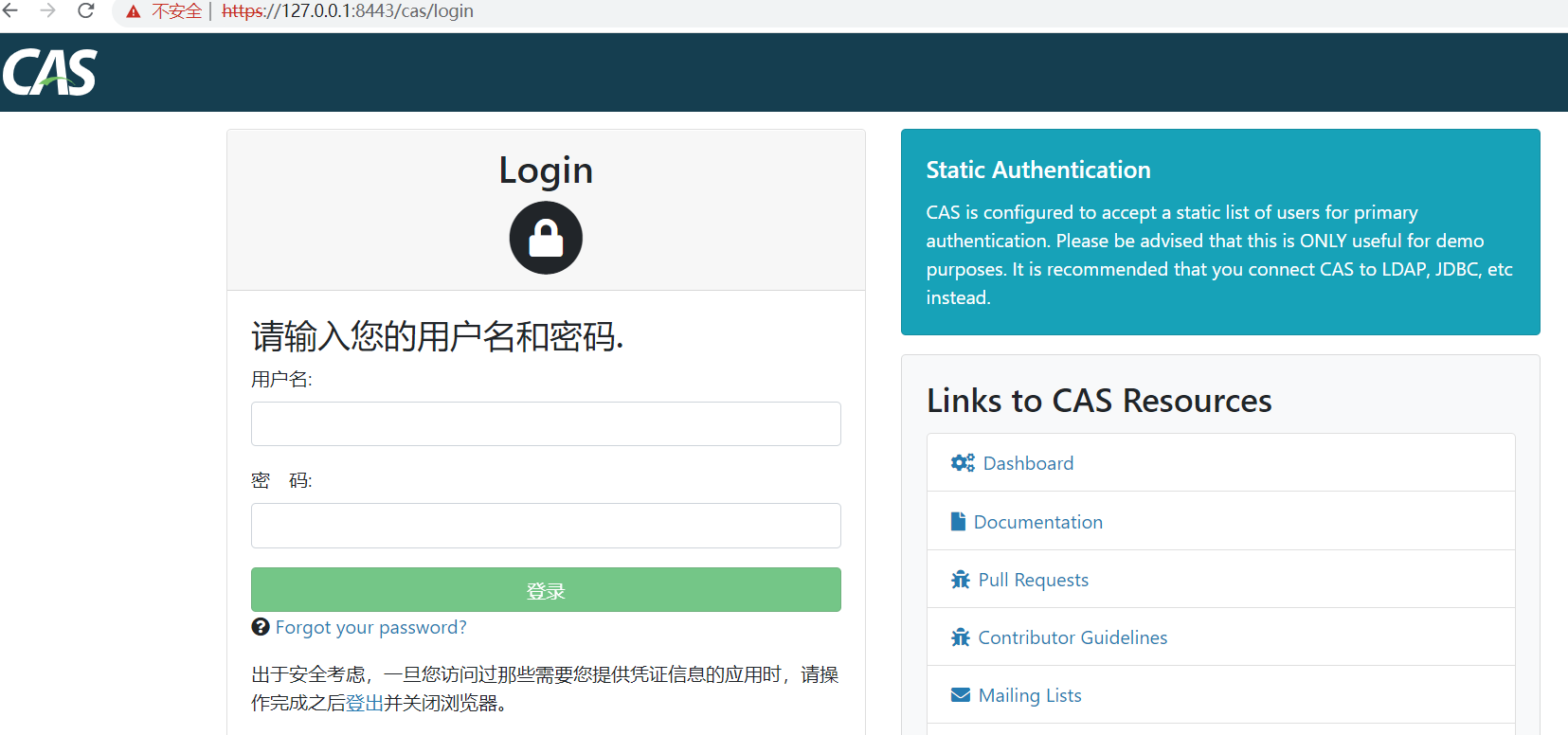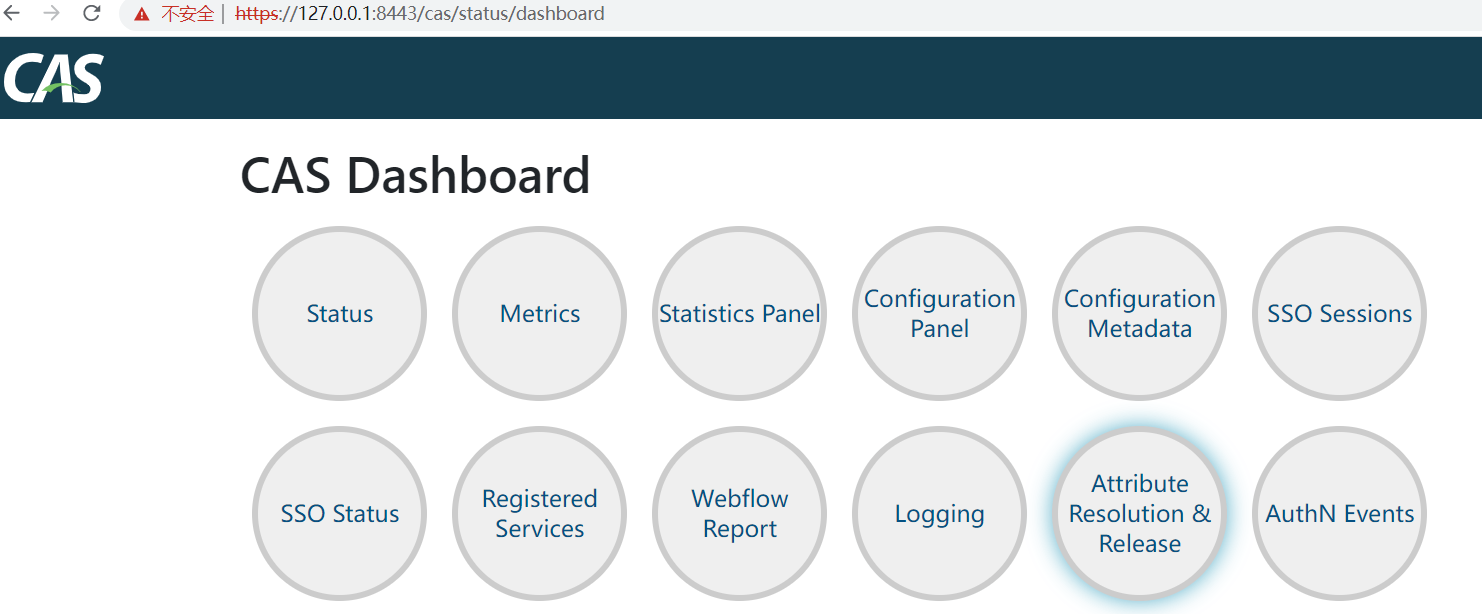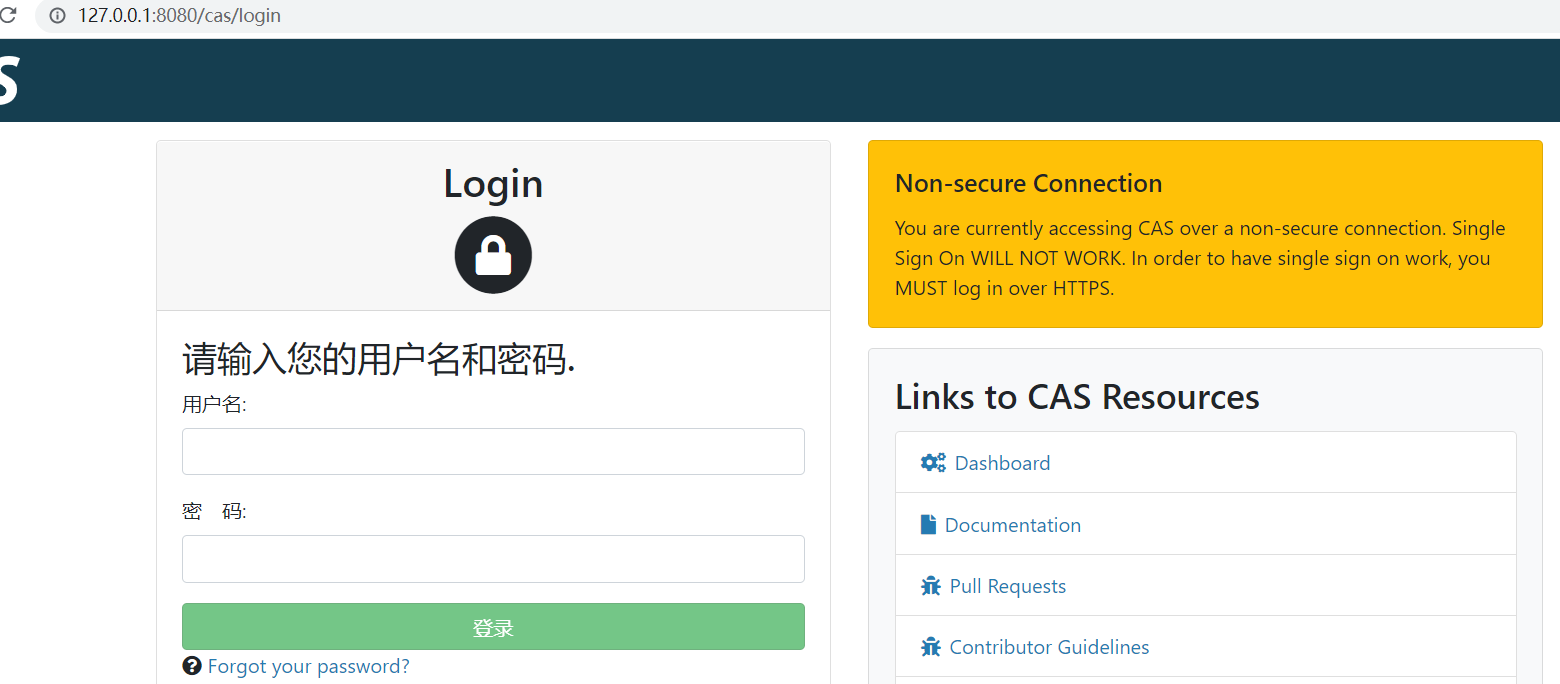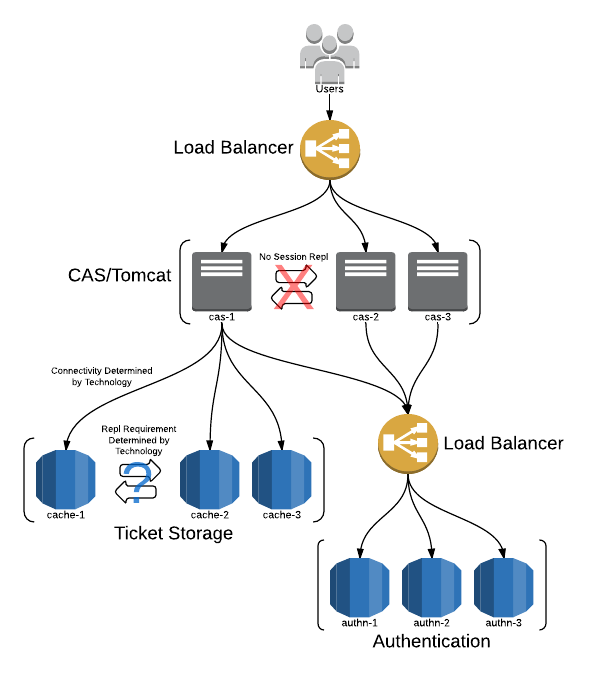一、背景介紹 最近幾天,谷愛凌在冬奧會賽場上奪得一枚寶貴的金牌,為中國隊貢獻了自己的榮譽! 針對此熱門事件,我用Python的爬蟲和情感分析技術,針對小破站的彈幕數據,分析了眾網友彈幕的輿論導向,下麵我們來看一下,是如何實現的分析過程。 二、代碼講解-爬蟲部分 2.1 分析彈幕介面 首先分析B站彈幕 ...
本文主要介紹 CAS 服務端的安裝,使用到的軟體版本:JDK 1.8.0_191、Tomcat 8.5.76、CAS 5.3.16。
1、單機安裝
1.1、生成部署包
通過官方提供的 cas-overlay-template(https://github.com/apereo/cas-overlay-template/tree/5.3) 模板來生成部署包。
先 clone 項目到本地:
git clone https://github.com/apereo/cas-overlay-template.git -b 5.3
執行打包命令:
build.cmd package
命令執行完成之後會在 target 目錄下生成 cas 的 web 應用及 cas.war 的包。linux 環境可以使用 build.sh 腳本。
1.2、生成密鑰庫
CAS 預設需要使用 Https 來訪問,可使用 Java 的 keytool 工具來生成密鑰庫,然後使用該密鑰庫在 Tomcat 中配置 SSL。
D:\tmp>keytool -genkeypair -alias cas-tomcat -keyalg RSA -keystore casServer.keystore
1.3、Tomcat 中配置 SSL
在 conf/server.xml 中註釋掉原來的 Connector,新增一個 Connector:
<!--Connector port="8080" protocol="HTTP/1.1" connectionTimeout="20000" redirectPort="8443" /--> <Connector port="8443" protocol="org.apache.coyote.http11.Http11NioProtocol" maxThreads="150" SSLEnabled="true"> <SSLHostConfig> <Certificate certificateKeystoreFile="d:/tmp/casServer.keystore" certificateKeystoreType="JKS" certificateKeystorePassword="123456" /> </SSLHostConfig> </Connector>
1.4、修改日誌目錄
修改 WEB-INF\classes\log4j2.xml 文件中的日誌文件保存目錄:
<Properties> <Property name="baseDir">d:/tmp/logs</Property> </Properties>
1.5、部署應用
把 1.1 生成的 cas 應用目錄或 cas.war 拷貝到 Tomcat 的 webapps 目錄下並啟動 Tomcat;啟動完成後訪問應用:https://127.0.0.1:8443/cas,預設用戶名密碼為:casuser/Mellon

1.6、查看 Dashboard
目前情況下是沒有許可權查看 Dashboard 的,需要在 WEB-INF\classes\application.properties 中放開許可權:
#修改如下配置,開啟監控端點 cas.monitor.endpoints.enabled=true cas.monitor.endpoints.sensitive=false #新增如下配置,設置能訪問的ip,.+ 表示任意ip cas.adminPagesSecurity.ip=127.0.0.1
修改完後重啟 Tomcat,重新登錄:

1.7、JDBC 認證登錄
預設情況下用戶信息配置在 WEB-INF\classes\application.properties 中:
cas.authn.accept.users=casuser::Mellon
CAS 支持通過 JDBC 方式認證登錄,以滿足實際生成的需要。
1.7.1、引入 JDBC 的組件
在 clone 項目的 pom.xml 文件中增加如下配置(紅字部分):
<dependencies> <dependency> <groupId>org.apereo.cas</groupId> <artifactId>cas-server-webapp${app.server}</artifactId> <version>${cas.version}</version> <type>war</type> <scope>runtime</scope> </dependency> <!-- ...Additional dependencies may be placed here... --> <dependency> <groupId>org.apereo.cas</groupId> <artifactId>cas-server-support-jdbc</artifactId> <version>${cas.version}</version> </dependency> <dependency> <groupId>org.apereo.cas</groupId> <artifactId>cas-server-support-jdbc-drivers</artifactId> <version>${cas.version}</version> </dependency> <dependency> <groupId>mysql</groupId> <artifactId>mysql-connector-java</artifactId> <version>8.0.28</version> </dependency> </dependencies>
重新打包 build.cmd package,再把應用重新部署到 Tomcat 中。
1.7.2、創建用戶表
個應用系統一般都有用戶表,這一步是不需要的;這裡為了演示創建一個測試的用戶表:
CREATE TABLE `cas_user` ( `id` bigint PRIMARY KEY, `user_name` varchar(32) NOT NULL COMMENT '用戶名', `password` varchar(64) NOT NULL COMMENT '密碼', `create_time` datetime COMMENT '創建時間', `expired_flag` int(1) NOT NULL DEFAULT 0 COMMENT '是否過期', `disabled_flag` int(1) NOT NULL DEFAULT 0 COMMENT '是否有效' )
並插入測試數據,密碼使用 MD5 加密,這裡密碼為 123456,MD5 加密後用十六進位表示為:e10adc3949ba59abbe56e057f20f883e
insert into cas_user(id,user_name,password,create_time) values (1,'test','e10adc3949ba59abbe56e057f20f883e',now());
1.7.3、應用中配置資料庫信息
在 WEB-INF\classes\application.properties 中修改配置:
#該行註釋掉 #cas.authn.accept.users=casuser::Mellon #增加下列配置 #查詢用戶信息的SQL,會把用戶名作為參數傳進來 cas.authn.jdbc.query[0].sql=select * from cas_user where user_name=? #指定密碼欄位 cas.authn.jdbc.query[0].fieldPassword=password #指定過期欄位 cas.authn.jdbc.query[0].fieldExpired=expired_flag #指定是否可用欄位 cas.authn.jdbc.query[0].fieldDisabled=disabled_flag cas.authn.jdbc.query[0].dialect=org.hibernate.dialect.MySQLDialect cas.authn.jdbc.query[0].driverClass=com.mysql.cj.jdbc.Driver cas.authn.jdbc.query[0].url=jdbc:mysql://10.49.196.10:3306/cas?useUnicode=true&characterEncoding=UTF-8&useSSL=false cas.authn.jdbc.query[0].user=root cas.authn.jdbc.query[0].password=123456 #預設加密策略,NONE 不加密 cas.authn.jdbc.query[0].passwordEncoder.type=DEFAULT cas.authn.jdbc.query[0].passwordEncoder.characterEncoding=UTF-8 cas.authn.jdbc.query[0].passwordEncoder.encodingAlgorithm=MD5
重啟 Tomcat,使用 test/123456 登錄 CAS 系統。
1.8、使用 Http 方式登錄
由於 Https 需要配置證書,比較麻煩,也不方便 CAS 客戶端和 CAS 服務端的通信,可以修改為使用 Http 訪問系統。
1.8.1、修改 HTTPSandIMAPS-10000001.json 文件
修改 WEB-INF\classes\services\HTTPSandIMAPS-10000001.json,增加 http 協議:
{ "@class" : "org.apereo.cas.services.RegexRegisteredService", "serviceId" : "^(https|http|imaps)://.*", "name" : "HTTPS and IMAPS", "id" : 10000001, "description" : "This service definition authorizes all application urls that support HTTPS and IMAPS protocols.", "evaluationOrder" : 10000 }
1.8.2、修改 application.properties 文件
修改 WEB-INF\classes\application.properties 文件,增加如下配置:
cas.tgc.secure=false cas.warningCookie.secure=false cas.serviceRegistry.initFromJson=true
1.8.3、Tomcat 改回 Http 協議
刪除原來 Https 的配置,複原原始配置:
<Connector port="8080" protocol="HTTP/1.1" connectionTimeout="20000" redirectPort="8443" />
重啟 Tomcat,通過 Http 協議訪問 CAS:

2、集群安裝
2.1、集群架構
官方推薦的集群架構如下:

2.2、集群規劃
| ip | 用途 |
| 10.49.196.10 | CAS 服務端 |
| 10.49.196.11 | CAS 服務端 |
| 10.49.196.12 | nginx,redis |
這裡 redis 使用單機版,實際應用中可以使用 redis 的哨兵模式,防止單點故障。
2.3、票據持久化
預設票據保存在記憶體中,集群中個節點無法共用;CAS 提供多種票據持久化的方法,如:JMS、JPA、MongoDB、Redis、Cassandra 等等,這裡使用 Redis 來持久票據。
2.3.1、引入依賴
在 cas-overlay-template 的 pom.xml 文件中引入相關依賴:
<profile> <activation> <activeByDefault>true</activeByDefault> </activation> <id>default</id> <dependencies> <dependency> <groupId>org.apereo.cas</groupId> <artifactId>cas-server-webapp${app.server}</artifactId> <version>${cas.version}</version> <type>war</type> <scope>runtime</scope> </dependency> ...... <dependency> <groupId>org.apereo.cas</groupId> <artifactId>cas-server-support-redis-ticket-registry</artifactId> <version>${cas.version}</version> </dependency> </dependencies> </profile>
重新打包 build.cmd package,再把應用重新部署到 Tomcat 中。
2.3.2、配置 Redis 信息
在 WEB-INF\classes\application.properties 中增加配置:
cas.ticket.registry.redis.host=10.49.196.12 cas.ticket.registry.redis.database=0 cas.ticket.registry.redis.port=6379 cas.ticket.registry.redis.usePool=true
詳細說明可參考官方文檔:https://apereo.github.io/cas/6.5.x/ticketing/Redis-Ticket-Registry.html (5.3 版本的文檔已經沒有了,這裡使用 6.5 版本的文檔);配置完後,重啟應用即可。
2.4、Session 持久化(可選)
Session 持久化用於 CAS 實例之間共用會話狀態和會話故障轉移;這一步是可選的,不建議使用,因為用戶 CAS 會話往往是短期的,並且體驗更像是請求-響應風格,而不是面向會話的。
2.4.1、引入依賴
在 cas-overlay-template 的 pom.xml 文件中引入相關依賴:
<profile> <activation> <activeByDefault>true</activeByDefault> </activation> <id>default</id> <dependencies> <dependency> <groupId>org.apereo.cas</groupId> <artifactId>cas-server-webapp${app.server}</artifactId> <version>${cas.version}</version> <type>war</type> <scope>runtime</scope> </dependency> ...... <dependency> <groupId>org.apereo.cas</groupId> <artifactId>cas-server-webapp-session-redis</artifactId> <version>${cas.version}</version> </dependency> </dependencies> </profile>
重新打包 build.cmd package,再把應用重新部署到 Tomcat 中。
2.4.2、配置 Session 持久信息
在 WEB-INF\classes\application.properties 中增加配置:
cas.webflow.session.storage=true spring.session.store-type=redis spring.redis.host=10.49.196.12 spring.redis.port=6379
詳細說明可參考官方文檔:https://apereo.github.io/cas/6.5.x/webflow/Webflow-Customization-Sessions.html (5.3 版本的文檔已經沒有了,這裡使用 6.5 版本的文檔);配置完後,重啟應用即可。
2.5、代理配置
這裡使用 Nginx 作為代理伺服器,配置如下:
http { ...... upstream cas { server 10.49.196.10:8080 weight=1; server 10.49.196.10:8081 weight=1; ip_hash; } server { listen 8080; server_name localhost; ...... location /cas { proxy_pass http://cas/cas; } } }
啟動 Nginx 後,就可以通過 http://10.49.196.12:8080/cas 來訪問 CAS 了。



